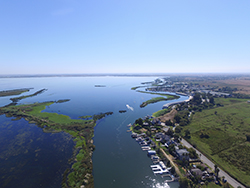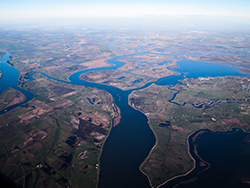

In the heart of California’s Sacramento-San Joaquin River Delta lies a 3,000-acre flooded island called Franks Tract.
Before humans diked and drained Franks Tract to grow potatoes, grains, asparagus and corn, the island was part of a vast freshwater marsh. Breaches in levees flooded Franks Tract in 1937, and farmers never reclaimed the island. Franks Tract today is a nexus point of many delta uses, ranging from duck hunting and bass fishing to fresh water supply for California cities and farms.
But the island is also a hot spot for invasive plants and predatory fishes, as well as a conduit for saltwater intrusion into waterways used to convey freshwater supplies to cities and agriculture in the Delta and other parts of California. For these reasons, Franks Tract is considered a strong candidate for partial restoration.
“Franks Tract is a microcosm of many of the larger problems pervading the inner Delta, said Carl Wilcox, Delta policy advisor to the director of the California Department of Fish and Wildlife. “Some native fishes are in serious decline, improving the quality of available habitat in the Delta and increasing resilience to drought and climate change could support their persistence and recovery.”
Various partners, led by CDFW, are proposing to restore about 1,000 acres of Franks Tract to tidal marsh. The proposed restoration is consistent with the Delta Smelt Resiliency Strategy, state goals for the Franks Tract State Recreation Area, and state water quality control plans for the San Francisco Estuary. The effort also aligns with the multi-agency Delta Conservation Framework and the Central Delta Corridor Partnership.
The proposed restoration could shrink waterweeds, grow fish food, create habitat for Delta smelt and other declining species, and prevent salinity intrusion into the south Delta. It may also improve recreational opportunities for residents and visitors.
Results of hydrodynamics modeling indicate the proposed restoration would provide more fresh water to the central Delta shielding regions upstream from ocean saltwater intrusion. A 2017 UC Davis survey documented year-round use of Franks Tract and surrounding channels by locals, visitors and researchers, and seasonal use by hunters, anglers and boaters. Many survey respondents were concerned about changes in access to the water and effects on the local economy and sport fishing, which is dependent on that access. The survey yielded useful information for the next, more detailed, planning and design round including a locally proposed alternative design.
“We will continue to work with stakeholders to not only address habitat and water quality priorities, but also enhance recreational and sport fishing opportunities,” Wilcox said.
A recently released report, Franks Tract Futures: Exploring Options for Multi-Benefit Restoration and Increased Resilience in the Central Delta Corridor, summarizes the technical studies and stakeholder input that’s been collected relative to the potential restoration of Franks Tract.
If approved for further development, the Franks Tract restoration proposal would enter a second phase of planning, design and environmental review with a target end date of December 2020.
CDFW Photos.